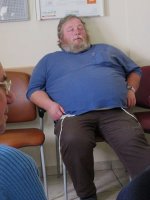Splendid set of suggestions about techniques. I'll just add a few of my personal observations and thoughts, mostly of philosophical nature.
I like to understand the dynamics of the people in the places I photograph... Observe the dynamics of the people in a city around 8:30 am in the morning, and how dramatically these evolve over time. Look a little further on, and we find completely different dynamics around lunch-time, and then again around 5:00 pm. All this is certainly on a gigantic macroscopic scale, and at a sufficiently high level things become quite predictable. However, the abnormal in this relatively predictable environment makes for the most interesting and the eye-catching scenes. For instance, a backpacker studying a map in front of the union station in Chicago is clearly the odd man out at 8:30 am. Seldom are such oddities found, but misfits abound, providing nice studies in contrasts. The key is to know where to find them and when.
Sometimes I like to simply take a walk without a camera, try to feel the rhythm of the city, to enjoy the sights and sounds around me, ponder, and wonder. It is something like a mentally enriching tour, somewhat in the spirit of Virginia Woolf's ``The London Scene.'' It helps to understand, and in general predict. Sometimes I can predict an incident/scene long before it happens; I position myself, prepare the camera with all settings and focussing, and then enjoy like an Olympian god as the scene unfolds in front of me just as I had constructed a priori. Of course more often than not, random events change the course of the event, but those too are interesting, and give new insights in addition to being frustrating to some extent 🙂 In short, the more time I spend behind understanding the people, the better are the prospects of clinching scenes of interest, or even of daily life with sufficient soul in them that they stand out as photographs.
Enough said, now it's time to stop, wonder, and shoot 🙂
Just another little nudge, i.e., something to wonder internally... are ``street photographs'' limited to photographs on the street? Or is it about life... no matter what the venue? 🙄 (NB: I don't want to start a debate on this.)




